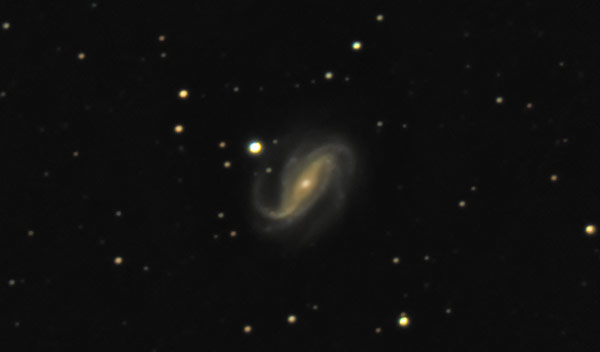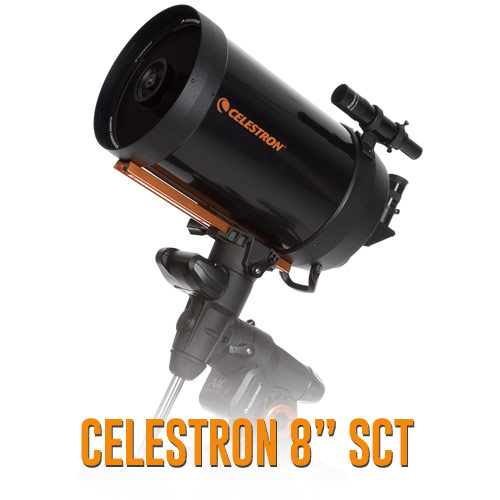Backyard of the Week – September 11, 2018
As the summer comes to a close, so do the hot, humid nights of astrophotography in the backyard. From my location in Southern Ontario, the temperature varies wildly throughout each season from 30+C in July to -30C in January.
In the neighboring province of Quebec, Dennys Turcotte braves the even colder winter temperatures of Montreal with his Celestron 8” SCT telescope. As you’ll see in the photo of his below, the unforgiving temperatures do not stop him from enjoying deep sky astrophotography.
Here is Dennys’ Celestron 8” SCT set up on a frozen lake. (You heard that right)
Location: Montreal, Canada
Dennys Turcotte
Does the telescope mount in the image above look a little different, it should! It was once an ordinary Celestron CG-5 equatorial GoTo mount, but it is now something that behaves completely differently. As Dennys puts it: “Despite being an ‘introduction’ grade mount, it has given me hundreds of hours of spot-on guiding performance.”
Interestingly enough, the Celestron Advanced Series CG-5 was the first equatorial mount I ever used for astrophotography, but mine was not hypertuned. This model has since been discountinued and replaced with the Advanced VX model.
Celestron 8 SCT with Advanced VX Mount
I’ll get into the exact details of this interesting transformation momentarily, but for now, let’s look at an overview of Dennys’ deep sky setup:
- Mount: Celestron CG-5 (hypertuned)
- Telescope: Celestron 8” SCT (Schmidt-Cassegrain Telescope)
- Reducer: Antares F/6.3 Focal Reducer for SCT
- Camera: ZWO ASI1600 MC Cool
- Guidescope: ZWO 60mm F/4.6 Guidescope
- Guide Camera: Orion Starshoot Autoguider
- Polar Alignment: QHY Polemaster
Here is what our featured amateur astrophotographer has been able to accomplish using this setup:
NGC 613 by Dennys Turcotte
You can view more of Dennys’ astrophotography images on his Astrobin profile. He has amassed an impressive number of images using the 8-inch SCT and other telescopes.
M27 by Dennys Turcotte
Telescope Mount:
My first equatorial mount for deep sky astrophotography was the Celestron CG-5. The “Advanced Series GT” to be exact. This is a rather affordable computerized GoTo mount, and is responsible for many of my first successful deep sky images.
I am impressed to see a heavy 8 SCT being used so successfully on the CG-5, as I used a much lighter 80mm refractor and DSLR camera with mine. Dennys lists his mount as being “hypertuned”, which he actually performed himself! There are services that will do this for you as well.
(There are also DIY hypertune kits available for the CG5)
Telescope:
I must admit, I’ve never used a Schmidt-Cassegrain telescope. The Celestron 8 SCT featured here has a much longer focal length than I am used to with my refractors. With a reach of 2032mm and a focal ratio of F/10, this is a completely different animal than my wide-field refractors.
The 8-inch Celestron SCT is one of the most popular telescopes in the world, because it offers a unique balance of visual and photographic performance. 8” is a lot of aperture to fit into a compact and short tube. An SCT can be an excellent choice if you plan on taking photos of planets.
Celestron 8 SCT Telescope Specs:
- Optical Design: Schmidt-Cassegrain
- Aperture: 203 mm (8 inches)
- Focal Length: 2032 mm
- Focal Ratio: F/10
- Optical Tube Weight: 13 lbs
Focal Reducer:
Dennys uses an Antares F/6.3 focal reducer to reduce the exposure time needed on his Celestron 8 SCT. This inexpensive focal reducer threads on to the rear cell of Denny’s Celestron 8 SCT and is a popular option for owners of these telescope systems.
The Antares F/6.3 focal reducer for F/10 SCT
Camera:
The ZWO ASI1600MC Cool is a 16MP one-shot-color CMOS astronomy camera. I have used a number of ZWO ASI color cameras in the past and was extremely impressed with my results. The built-in thermoelectric cooling system allows Dennys to take long exposure shots without introducing too much noise. During the winter, I don’t think Dennys needs to cool the camera much, as he mentioned imaging on a -33C night earlier this year!
Autoguiding:
Riding atop the 8 inch SCT is a compact 60mm ZWO F/4.6 guidescope. This little telescope has a focal length of 280mm and a helical focuser. This houses an Orion Starshoot autoguider camera which is an excellent fit for small guidescopes like this.
Polar Alignment:
The QHY Polemaster makes another appearance in the backyard of the week. The polemaster makes it easy to accurately polar align your mount without having to get down on the ground and look through a polar scope. The Polemasters are extremely accurate, you just have to make sure you order the proper adapter for your specific telescope mount.
The Whirlpool Galaxy and Iris Nebula by Dennys Turcotte
Thank you for sharing your backyard astrophotography setup with us, Dennys!
For a chance to be featured as the Backyard of the Week, please fill out this form and include the details of your setup. This is a great way for beginners to see a deep-sky imaging setup that is being used to successfully photograph the night sky.
Please include a link to your online gallery (website, Flickr gallery, Astrobin) so that I can share your imaging results on this page. If you have already submitted your backyard setup without a link to your gallery, please feel free to make another submission!
Helpful Resources:
Building a deep sky astrophotography kit from scratch
Choosing a camera for astrophotography
Top 5 astrophotography telescopes for a beginner





